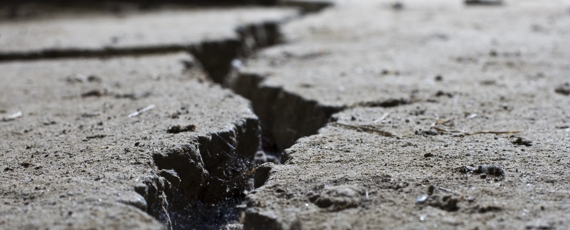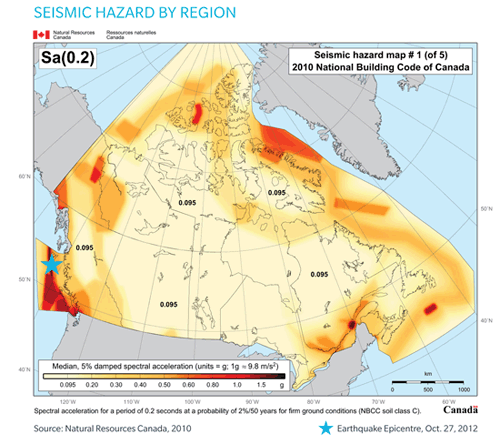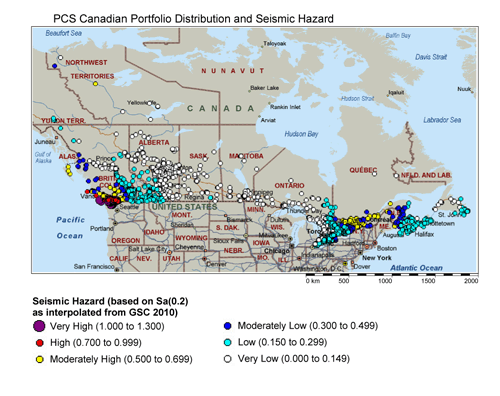Earthquake Risk in Canada

On the same weekend that “Superstorm Sandy” was threatening the east coast, a major earthquake occurred in the Haida Gwaii (previously known as the Queen Charlotte Islands) region of British Columbia (BC).
This earthquake measured a surprising magnitude of 7.7, but did not result in any reported damage mostly due to its remote location (approximately 730 km NW of Vancouver, 230 km SW of Prince Rupert)—see epicentre location on the map below.

In fact, if we look at all of the earthquake events that have affected North America since January 1, 2000, this recent event is second in magnitude only to the Denali earthquake in Alaska (Nov. 3, 2002).
From the hazard map above, we can clearly see that seismic hazard should be a concern not only in southwestern BC, but also in eastern Canada along the St. Lawrence Seaway and in the Montreal/Ottawa corridor.
Along Canada’s west coast, everyone is bracing for “The Big One.” This is the media’s term for the next Cascadia subduction event in which the Juan de Fuca plate will take another dive beneath the North American tectonic plate. According to geological evidence, this movement generally occurs approximately every 300 to 800 years (with the last movement occurring in the year 1700).
Subduction events (megathrust earthquakes) are the most powerful of all earthquake events, typically rating 8 or 9 on the Richter scale. These earthquakes often involve significant movement of land masses (both horizontally and vertically), and due to the fact that it will occur offshore (southwest of Vancouver Island), the formation of tsunamis is almost certain. While the “shake damage” will be widespread, from the perspective of a single site, damage is likely to be less than what would be expected from a smaller earthquake that could occur at closer proximity.
In the east, earthquakes are expected to be smaller and less probable. However, when they occur, they are expected to be felt over a much larger region (due to the existing geology of the North American plate). This reduction in the rate of energy dissipation (attenuation) along with an older building stock, and (until very recently) a lack of seismic design requirements in the building code has led many to believe that an earthquake in eastern Canada could also result in a significant impact to Canadians.
Earthquake risk does exist in Canada. The hazard, however, is not the same across the country. Understanding your specific risk is an important step if these risks are to be minimized or mitigated (or risk transferred through insurance).
Earthquake Risk to Clients of Marsh’s Private Client Services
Marsh’s Private Client Services (PCS) currently brokers residential insurance for over 35,000 separate properties throughout Canada, with the five most significant concentrations of reported values located in Toronto, Vancouver, Calgary, Edmonton, and Ottawa.
If we superimpose the locations of our current PCS client base over an earthquake hazard map for Canada, we get a fairly clear picture of how the seismic hazard could impact your particular property.

The regional seismic hazard that is inferred from the above image is based on the assumption of “firm” soil conditions. If buildings are based on soft soils, the hazard level probably should be increased by one level. Similarly if a property is based on “hard rock,” the hazard level could probably be reduced by one level.
Based on our analysis, it is estimated that 18 percent of the total PCS program property values are located in regions in BC where the hazard is considered either “High” or “Very High.” Of note, only approximately 50 percent of these properties currently elect to carry earthquake insurance.
The properties that rate “Moderately High” in seismic hazard are predominantly concentrated in the Ottawa region. Our records indicate that less than 8 percent of these policyholders have elected to carry earthquake insurance.
It is inevitable that someday a significant earthquake will affect a populated region of our country. Although comprehensive property insurance policies will cover the risk of damage caused by fire, theft, and a broad range of perils, insurance coverage for earthquake damage must be specifically chosen by property owners because it is typically excluded from the basic policy.
